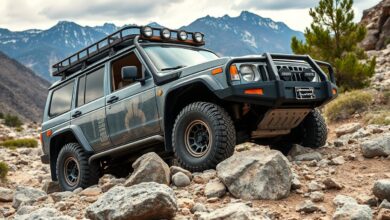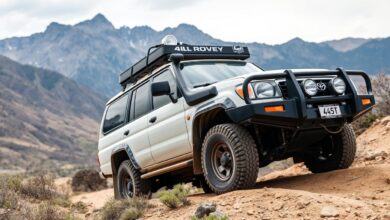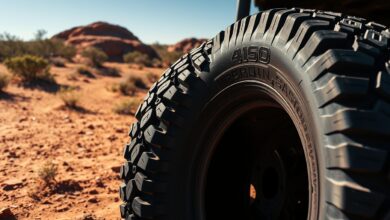The Best Roof Racks to Upgrade Your 4WD
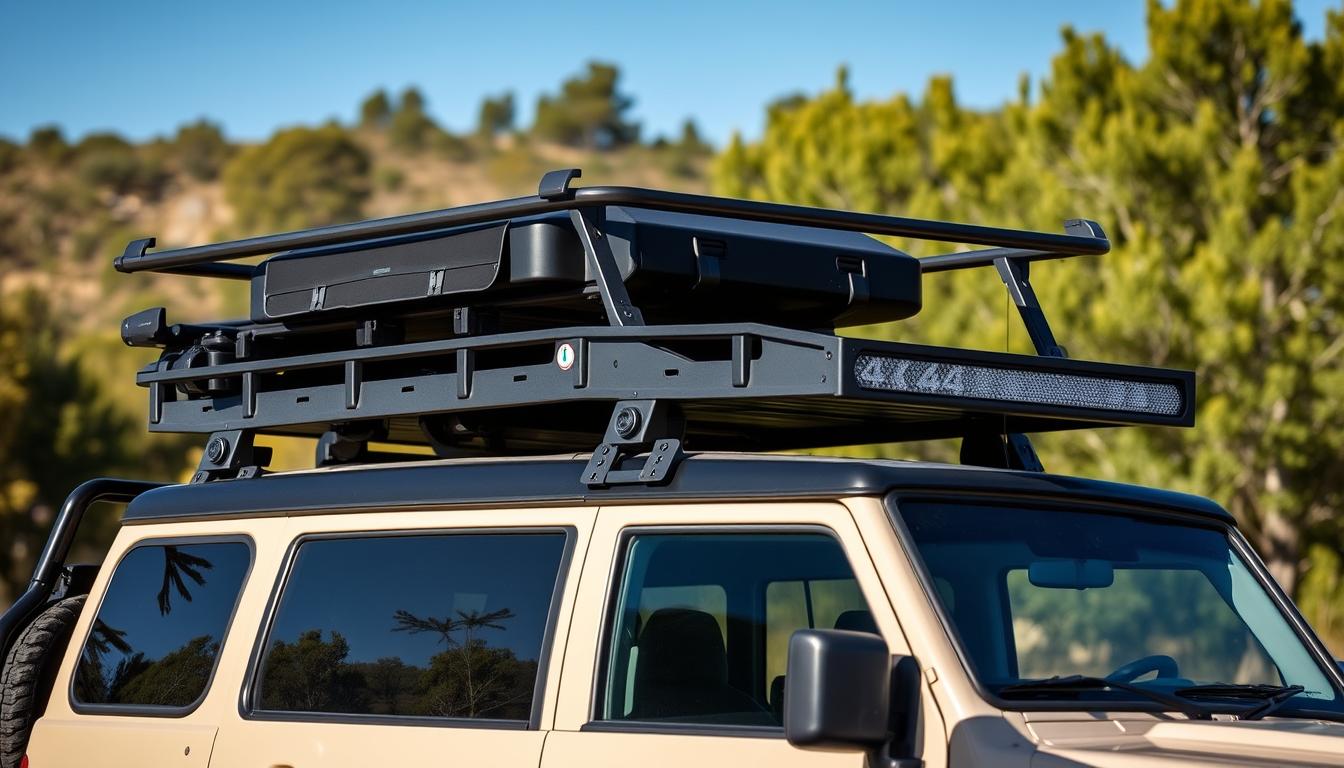
For 4×4 enthusiasts in Australia, the right gear is key for a great trip. A good 4×4 roof rack is essential. It safely carries your gear and makes travel easier.
Roof racks add storage and keep your car tidy. With many options, picking the right 4×4 roof rack can be tough.
This guide will help you understand the benefits of 4×4 roof racks. You’ll learn about the different types and how to choose the best one for your car.
Key Takeaways
- Understand the importance of 4×4 roof racks for your adventures.
- Learn about the different types of 4×4 roof racks available.
- Discover tips for choosing the right 4×4 roof rack for your vehicle.
- Explore the benefits of using a 4×4 roof rack.
- Find out how to maximize storage space with a 4×4 roof rack.
Why Invest in a 4×4 Roof Rack?
Getting a 4×4 roof rack can really boost your vehicle’s abilities. It’s perfect for those who love off-road adventures. A roof rack adds storage space, letting you carry more gear and equipment.
Benefits of a Roof Rack for Adventurers
A 4×4 roof rack offers many perks for adventurers. It lets you haul big items like rooftop tents and cargo carriers. This way, you can maximize your vehicle’s storage and be ready for anything.
Carrying more gear means you’re always prepared. Whether it’s camping stuff, recovery tools, or extra supplies, a roof rack has your back. It makes your adventure better by letting you bring what you need.
Enhancing Your Vehicle’s Capacity
A rooftop cargo carrier or an off-road roof rack boosts your vehicle’s storage. It uses roof space, freeing up room inside for people or other important items.
This is great for long trips or big adventures where space is tight. With a roof rack, your vehicle is ready for anything. It makes your journey more comfortable and fun for everyone.
Types of Roof Racks Available
4×4 roof racks come in many styles. Each is made for different needs and likes. Knowing the types is key, whether you need a strong rack for heavy loads or a flexible one for your rooftop tent.
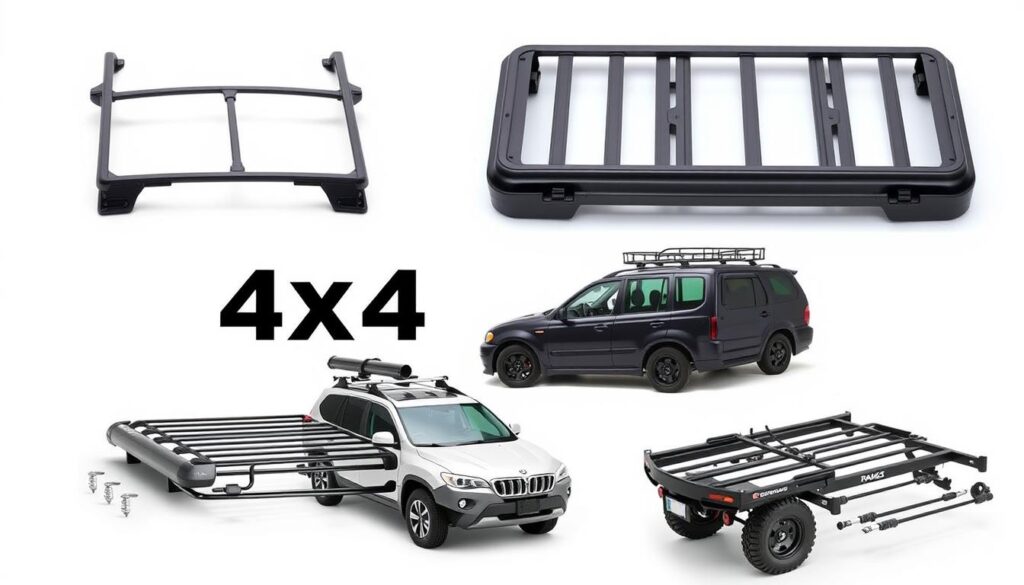
Fixed vs. Removable Roof Racks
Choosing between fixed or removable roof racks is important. Fixed roof racks are attached to the roof and are very stable. They’re great for those who use their rack a lot.
Removable roof racks are more flexible. They can be taken off when not needed. This improves fuel efficiency and protects your vehicle in tight spots. They’re ideal for occasional use or changing setups.
Platform vs. Basket Style
Deciding between platform and basket-style racks is another big choice. Platform roof racks offer a flat surface for heavy items like rooftop tents. They’re versatile and work with many accessories.
Basket-style roof racks are traditional with bars for cargo. They’re lighter and can cut down wind resistance. This makes them good for those who value speed.
Think about what you need when picking a rack. Consider the cargo, how often you’ll use it, and your vehicle’s details. For a rooftop tent, a strong platform rack is best. But for occasional use, a removable basket-style rack might be better.
Choosing the Right Roof Rack for Your 4×4
Choosing the right roof rack for your 4×4 is important. It boosts your vehicle’s storage and adventure capabilities. But, with so many options, picking the right one can be tough.
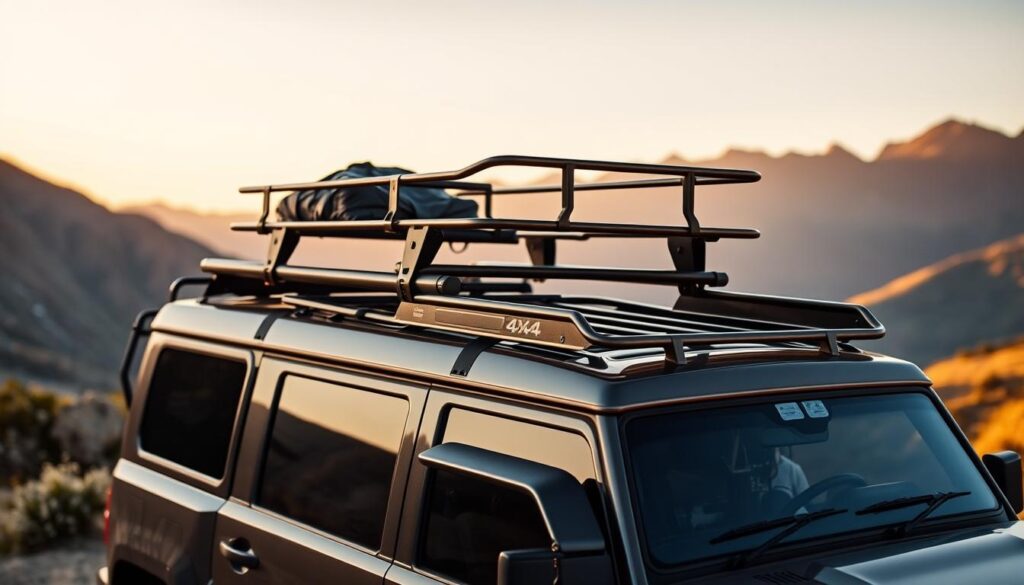
Vehicle Compatibility Considerations
First, make sure the roof rack fits your 4×4. Different vehicles have different roofs. You need a rack made for your vehicle’s make and model. Checking the manufacturer’s specifications and talking to experts is key.
Also, think about your 4×4’s roof type. Some racks fit flush roofs, others raised or rails. The right fit ensures safety and avoids damage.
Weight Capacity and Durability
The roof rack’s weight capacity is also important. It must handle the weight of your gear. Durable roof racks are usually made from strong materials like aluminum or steel.
Look at the rack’s material, construction, and any special features like rust protection. A strong rack means safety and peace of mind.
Reading 4×4 roof rack reviews and asking others can help. This way, you can choose a rack that suits your needs and improves your outdoor adventures.
Installation Tips for Your Roof Rack
Adding a roof rack to your 4×4 boosts storage and opens up new adventures. Roof racks are great for carrying camping gear, bikes, and kayaks.
DIY Installation vs. Professional Help
Deciding to install a roof rack yourself or get a pro to do it is a big choice. DIY installation saves money if you have the right tools and follow instructions well. But, if your car’s roof is complex or you’re unsure, getting a pro is safer.
Professionals ensure the roof rack fits right, avoiding damage to your car or the rack. Many stores offer installation services, sometimes for free with a roof rack purchase.
Tools You Might Need
For DIY, you’ll need basic tools like a drill, socket wrench, and adapters. Check the manufacturer’s guide for the exact tools needed.
- Drill and bits
- Socket wrench
- Adapters for your vehicle’s roof type
- Torque wrench for secure tightening
Having the right tools makes installation easier and ensures your roof rack is safe.
Whether DIY or professional, always check the roof rack’s fit before loading it. Regular checks keep your roof rack safe and in good shape.
Accessories That Complement Your Roof Rack
To get the most out of your 4×4 roof rack, check out the many accessories available. These extras can make your roof rack work better, giving you more places to store things for your adventures.
Cargo Bags and Baskets
Cargo bags and baskets are key for any roof rack. They add extra space for your luggage, camping gear, or other stuff. You can find them in different sizes and materials, so there’s something for everyone.
When picking a cargo bag or basket, think about size, material, and how easy it is to put on. Some have quick-release systems, making it simple to load and unload. For tips on picking the right cargo carrier, check out our guide to 4×4 roof racks.
Bike and Kayak Carriers
Bike and kayak carriers are special accessories for carrying your outdoor gear safely. They fit different bikes and kayaks, ensuring a secure fit while you’re on the move.
- Bike carriers have adjustable arms for different bike sizes and styles.
- Kayak carriers spread the weight out, so it doesn’t put too much strain on your roof rack.
Both bike and kayak carriers are great for those who love the outdoors. They let you take your favorite gear on your adventures. When choosing a carrier, look at the weight it can handle and if it fits your roof rack.
Maintenance Tips for Longevity
Keeping your durable roof racks in top shape is key. A well-kept roof rack lasts longer and keeps your cargo safe.
Regular Inspections and Cleaning
It’s important to check your roof rack often. Look for wear, loose bolts, or damage. Also, clean it regularly to stop corrosion.
- Inspect all bolts and fasteners to ensure they are tightened properly.
- Check the rack’s surface for any signs of damage or wear.
- Clean the roof rack with mild soap and water, avoiding harsh chemicals.
Protecting Against Rust and Wear
Keeping your off-road roof rack rust-free is vital. Use a rust-inhibiting coat, if you drive in harsh weather or off-road.
| Maintenance Task | Frequency | Benefits |
|---|---|---|
| Inspect bolts and fasteners | Every use | Ensures safety and security |
| Clean the roof rack | Monthly | Prevents corrosion and damage |
| Apply rust-inhibiting coating | Every 6 months | Extends the life of the roof rack |
By sticking to these maintenance tips, your 4×4 roof rack will stay in great shape. It’ll be ready for your next adventure.
Load Distribution: Maximizing Your Roof Rack
Proper load distribution is key when using a 4×4 roof rack. It makes sure your journey is safe and stable, whether you’re off-roading or driving on the highway.
Secure Loading Practices
To get the most out of your roof rack, follow best practices for loading. Spread the weight of your cargo evenly. Use a rooftop cargo carrier or other accessories to secure it well.
Safety Considerations
It’s important to know the height limits and secure your cargo when using a 4×4 roof rack. Not doing so can lead to accidents or damage to your vehicle.
Many adventurers have safely used 4×4 roof racks on their off-road trips. By following this Ultimate Guide to 4×4 Roof Racks, you can have a safe and fun adventure with your vehicle.
Real-Life Experiences
Brands like Thule and Rhino-Rack have received great reviews for their 4×4 roof racks. They are durable and perform well. By choosing the best 4×4 roof racks and following proper installation and loading, you can explore new places with your vehicle.
FAQ
What is the weight capacity of a typical 4×4 roof rack?
The weight capacity of a 4×4 roof rack depends on the brand and model. Most can carry between 50-150 kg. Always check your roof rack’s specs to avoid overloading.
Can I install a roof rack on my 4×4 vehicle myself?
You can try installing a roof rack by yourself. But, it’s safer to get a pro if you’re not sure. Wrong installation can harm your vehicle or the rack.
What are the benefits of using a rooftop cargo carrier?
A rooftop cargo carrier adds extra space for your stuff. It keeps your car tidy. It’s great for big items like camping gear or sports equipment.
How do I maintain my roof rack to ensure its longevity?
Keep your roof rack in good shape with regular checks and cleanings. Look for damage or rust. Use a rust protector on metal parts.
Can I use a roof rack with a rooftop tent?
Yes, many roof racks work with rooftop tents. Make sure your rack can handle your tent’s weight and size. Follow the maker’s install guide.
What are the safety considerations when using a roof rack?
Safety first with roof racks. Know the height limits, secure your load well, and spread the weight evenly. Check your rack and cargo often to avoid accidents.
Are there any specific roof rack accessories for off-road adventures?
Yes, there are many accessories like bike and kayak carriers, and cargo bags. They make your roof rack better for off-road trips.
How do I choose the right roof rack for my 4×4 vehicle?
Pick a roof rack based on your vehicle, weight needs, and durability. Look at different models, read what others say, and ask experts for advice.

